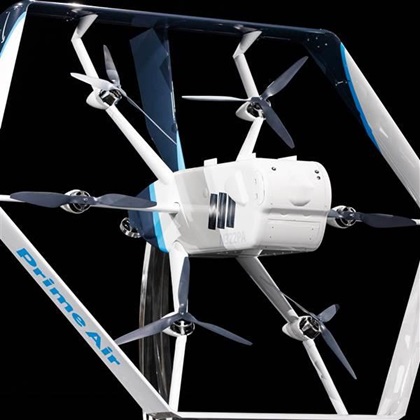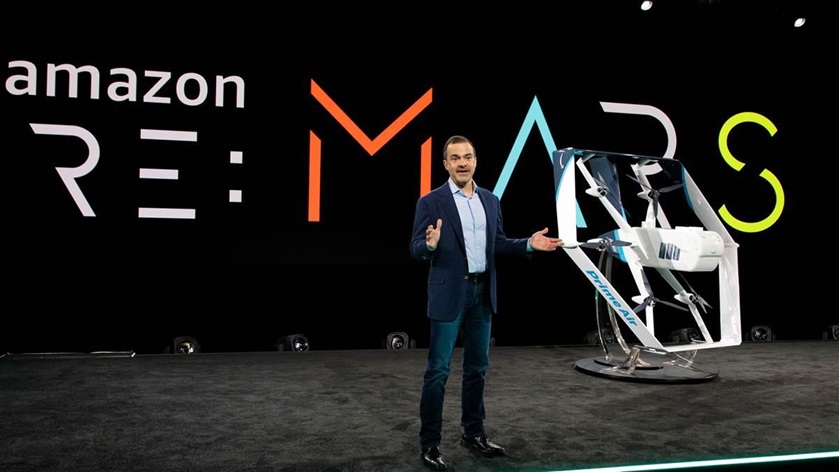Amazon unveils flying delivery robot
Package delivery said to be ‘months’ away
It uses computer vision and artificial intelligence to pick its way through obstacles, and Amazon Worldwide Consumer CEO Jeff Wilke declared it “independently safe,” introducing a new term into the aviation lexicon and attaching it to a radical new drone design.
While the FAA and the Association of Unmanned Vehicle Systems International hosted a three-day gathering in Baltimore to talk about drone policy and incremental change, Wilke and his team were in Las Vegas getting the smoke machines and audio system set for a June 5 reveal of an aircraft that represents a somewhat more radical departure from traditional flying machines than the typical “drone.”
“Our drones need to be able to identify static and moving objects coming from any direction. We employ diverse sensors and advanced algorithms, such as multi-view stereo vision, to detect static objects like a chimney,” Wilke wrote in a blog post. “To detect moving objects, like a paraglider or helicopter, we use proprietary computer-vision and machine learning algorithms.”
Amazon has been cooking up delivery drone prototypes for several years and flying them in relative secrecy overseas.The firm was not selected to participate in a federal program testing advanced drone technologies for a range of missions including package delivery, but they claim to have come up with their own solutions, including a solution to the most challenging problem facing the industry: enabling drones to detect and avoid aircraft that are not transmitting electronic signals of any kind.

The FAA registration information for the drone that appeared on stage with Wilke, and another shown in a YouTube video posted by Amazon (embedded above), list the new model as “MK27,” a tantalizing clue that this is the latest iteration in a long line of designs. Amazon continues to be coy about many of the specifics, citing trade secrets and fending off questions from Bloomberg and others. The FAA told Bloomberg that Amazon has been granted a one-year approval to test the new drones with many limitations, including a prohibition on deliveries, so it’s not entirely clear what prompts the international retail giant to predict test deliveries of items weighing up to five pounds will begin within “months.” (England and Australia have been more accommodating, so we shall see.)
Amazon's new drone looks very different from the prototype the firm brought to EAA AirVenture in Oshkosh, Wisconsin, in 2017, though the safety pitch is much the same. The collision avoidance burden will fall squarely on the drone. Amazon reports its new drone can fly up to 15 miles, hustling packages to customers within 30 minutes of a “place order” click. Wilke spent much of his blog post describing safety features, starting with a planform that wraps the propellers in a shroud, which doubles as an airfoil, allowing the aircraft to take off and land vertically and transition to a more efficient, airplane-like cruise.
“The distinctive aircraft is controlled with six degrees of freedom, as opposed to the standard four,” Wilke wrote. “This makes it more stable, and capable of operating safely in more gusty wind conditions. We know customers will only feel comfortable receiving drone deliveries if they know the system is incredibly safe. So we’re building a drone that isn’t just safe, but independently safe, using the latest artificial intelligence (AI) technologies.”
Wilke wrote that the computer-vision also detects utility wires, clotheslines, and other obstacles typically found around homes. “Through the use of computer-vision techniques we’ve invented, our drones can recognize and avoid wires as they descend into, and ascend out of, a customer’s yard.”
Amazon is also making an environmental pitch, noting that battery powered drones will help the company achieve the goal of making half of all shipments carbon-neutral by 2030.
While Wilke and colleagues had much to say, there’s a lot more to learn that they haven’t spelled out. A Massachusetts Institute of Technology aeronautics professor told Bloomberg he has many questions, and the FAA probably will have more than a few of their own.
Amazon’s announcement came weeks after the FAA approved the first commercial drone delivery service, allowing Alphabet Inc. subsidiary Wing to begin test deliveries, while United Parcel Service and Matternet are shuttling medical supplies and samples between hospitals in North Carolina. There is also Uber, working feverishly to design and deploy a new generation of electric air taxis, some of which may share some of the autonomous flying capabilities of the Amazon drones, scaled up to carry one or more people. Uber’s next Elevate summit will be held June 11 and 12 in Washington, D.C., so stand by, there may be some more smoke and music coming.




